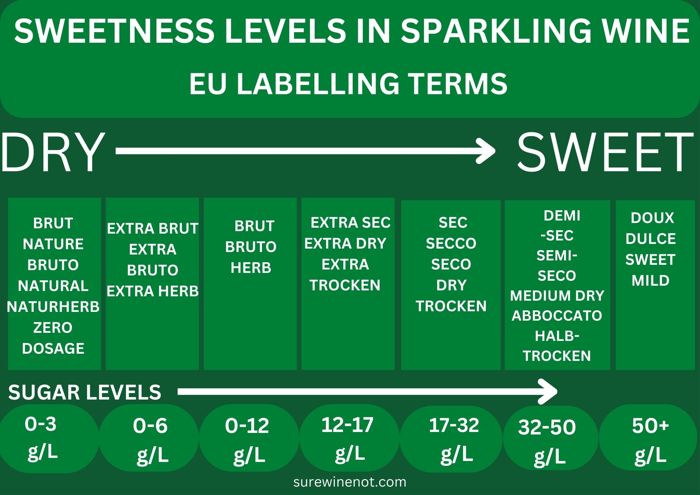Pét-Nat wine has become very trendy of late. But you may be wondering what it is exactly and how it is different to Champagne and Prosecco.
In this article, you will learn what Pét-Nat is, how it is made and how it compares with Champagne and Prosecco..

Pét-Nat, Champagne and Prosecco are all sparkling wines made using different methods.
Champagne is made using the traditional method, Prosecco is made using the tank method and Pét-Nat is made using the ancestral method.
Champagne and Prosecco are much more involved and controlled processes than that of Pét-Nat. Champagne and Prosecco are fermented twice and Pét-Nat only once.

Contents
What is Pét-Nat?
Pét-Nat is the abbreviated name for a type of sparkling wine typical to certain areas in France, such as the Loire Valley. Today it is made around the world using a variety of grapes.
Pét-Nat is short for Pétillant Naturel.
The word pétillant is French and is defined by Merriam Webster as “mildly and slowly effervescing”. In other words, it refers to the sparkle or bubbles in the wine. The bubbles are created naturally during the fermentation process. The intensity of sparkle/bubbles varies depending on how it was made.
Pét-Nat wines are usually dry or off-dry (meaning not sweet or slightly sweet) and have low or medium alcohol levels (11-13.9% abv).
Pét-Nat wines are made using the Ancestral Method.

How Pét-Nat wine is made/Ancestral Method
The ancestral method (méthode ancestrale) is so called because it is a very old method of making sparkling wines, which has become more popular in recent years. It is believed to be as much as 200 years older than the traditional method used to make Champagne.
This method is sometimes referred to by regional/local names. In France, it can also be called méthode rurale, artisanale or gaillacoise. In Germany, it is called méthode rural and in Italy Col Fondo.
The grape juice in the ancestral method is only fermented once. This differs from other sparkling wine methods where the wine undergoes a second fermentation, such as the traditional method (Champagne), transfer method and the tank method (Prosecco).
Fermentation of the grapes is stopped roughly halfway through.
The partially fermented wine is then bottled and the fermentation continues in the bottle. Any carbon dioxide (bubbles) produced by the continuing fermentation is captured in the bottle from this point on, giving it its natural carbonation.
Methods can differ depending on the winemaker; for example, sometimes the partially fermented grapes are chilled, filtered and stored in tanks for several months before bottling.
Pét-Nat sweetness levels
Dry Pét-Nat wines are wines where the sugars in the juice are fully fermented. Off-dry Pét-Nat have some sweetness from residual sugar that has not fermented.
Riddling and disgorgement
Some Pét-Nat wines are riddled and disgorged and some are not. Riddling and disgorgement is when the dead yeast (lees) sediment in the wine, caused by the fermentation, is moved to the neck of the bottle and removed.
Riddling is usually mechanized using a machine called a gyropalette. The wine is rotated and inclined moving the sediment to the neck of the bottle. Disgorgement is when the wine containing the sediment is removed.
Pét-Nat wines that are not riddled and disgorged can be cloudy and contain sediment.
Crown cap
Wines made using the ancestral method are recognizable by their crown cap, which looks like a beer bottle cap.
Pét-Nat alcohol content
The alcohol content of Pét-Nat wines is usually lower than other sparkling wines (except Asti). This is because most other sparkling wines are double fermented and Pét-Nat has a single fermentation. The second fermentation increases the alcohol levels in the wine.
The alcohol levels will vary, but 11 or 12% abv is typical.
Where Pét-Nat is made
Pét-Nat wine is traditionally French, but today it is made all over the world. Unlike Champagne or Prosecco, it is not a protected product that can only be made in specific areas or regions.
| Process | Pét-Nat | Champagne | Prosecco |
| Method | Ancestral | Traditional | Tank |
| Appellation Control | No (generally) | Yes | Yes |
| Where it is made | All over the world | Champagne region, France | North-East Italy |
| Grapes | Varies | Chardonnay, Pinot Noir, Meunier | Glera |
| Fermentation | Once | Twice (2nd in bottle) | Twice (2nd in tanks) |
| Liqueur de tirage* | No | Yes | Yes |
| Riddle & disgorge | Optional | Yes | No, filtered in tanks |
| Liqueur d’expédition* | No | Yes | Yes |
| Yeast autolysis* | Yes | Yes | Varies-usually no |
| Pressure (sparkle) | Varies | 5-6 atmospheres | 2-4 atmospheres |
| Min. ageing requirement | No | Yes | No |
| Closure | Crown cap | Cork | Cork |
*Liqueur de tirage is a mixture of wine, sugar, yeast, yeast nutrients and a clarifying agent.
*Liqueur d’expédition is a mixture of wine and sugar. The amount of sugar is called the dosage.
*Yeast autolysis gives wine biscuit, bread and toast aromas.
Pét-Nat vs Champagne
Champagne and Pét-Nat are both sparkling wines, but they are made using different methods. Champagne is made using the traditional method (méthode traditionnelle) and Pét-Nat is made using the ancestral method. There are various differences between these two methods.
Champagne is a highly controlled product and winemakers must adhere to strict rules on how it is made. This means that Champagne is a consistent and high-quality product.
Pét-Nat has little or no restrictions on how it is made, depending on where it is made (The EU has sparkling wine labelling rules for example). The methods and quality of Pét-Nat can therefore vary.

Main differences between methods:
Where it is made: Champagne can only be made in the Champagne region in France. Pét-Nat can be made anywhere.
Grape varieties: Champagne uses specific grapes. Pét-Nat has no restrictions on what grapes it can be made with.
Fermentation: Champagne is fermented twice and Pét-Nat is fermented once.
Champagne is always riddled and disgorged. Pét-Nat may or may not be riddled and disgorged.
Sparkle: The pressure in Champagne (how much sparkle) is five to six atmospheres. Pét-Nat wines vary in pressure from one to four or five atmospheres.
Sweetness levels: Pét-Nat is usually dry or off-dry. There is a much wider range of sweetness levels in Champagne.
Ageing: Champagne has minimum ageing requirements. Pét-Nat does not have minimum ageing requirements.
Closure: Champagne is closed with a Champagne cork, foil and a wire cage. Pét-Nat is closed with a crown cap.
Prosecco vs Pét-Nat
Prosecco is usually made using the tank method. Prosecco can only be made in a specific region in Italy.
Prosecco is a fruity and fresh wine with flavors of apple and melon. It is not suitable for ageing and should be consumed when it is young.

Main differences between methods:
Where it is made: Prosecco is made in the North-East of Italy. Pét-Nat is made all over the world.
Grape varieties: Prosecco is made primarily with the Glera grape. Pét-Nat is made from a variety of different grapes.
Fermentation: Prosecco is twice fermented. The second fermentation takes place in tanks. Pét-Nat is fermented once.
Filtering: Prosecco is filtered under pressure in tanks before bottling. Pét-Nat may or may not be riddled and disgorged.
Sparkle: The pressure in Prosecco (how much sparkle) is two to four atmospheres. Pét-Nat wines vary in pressure from one to four or five atmospheres.
Sweetness levels: Pét-Nat is usually dry or off-dry. Prosecco is made in Brut, Extra-dry and Dry styles.
Ageing: Prosecco is not aged for long periods and should be consumed while young and fresh. Pét-Nat wine should also be consumed young.
Closure: Prosecco is closed with a cork, and covered with a wire cage. Pét-Nat is closed with a crown cap.

Is Pét-Nat natural wine?
Pét-Nat wines can be natural wines, but don’t assume that they are. The naturel in the name refers to the bubbles being natural, rather than that the winemaking methods.
There is no official definition of what natural wine is; however, natural wines are usually:
- made by small independent winemakers using hand-picked grapes from organic or biodynamic vineyards.
- not filtered or fined.
- made with natural yeasts only.
- not made with sulfites or additives (little or none).
So, if you want to drink a natural Pét-Nat wine, you will need to look for these things on the label or research the winemaker’s methods.





